The World’s Easiest B2B eCommerce Storefront
The best B2B eCommerce & wholesale storefront in the game. Maintained, optimized, and hosted with fast performance by us, for you.
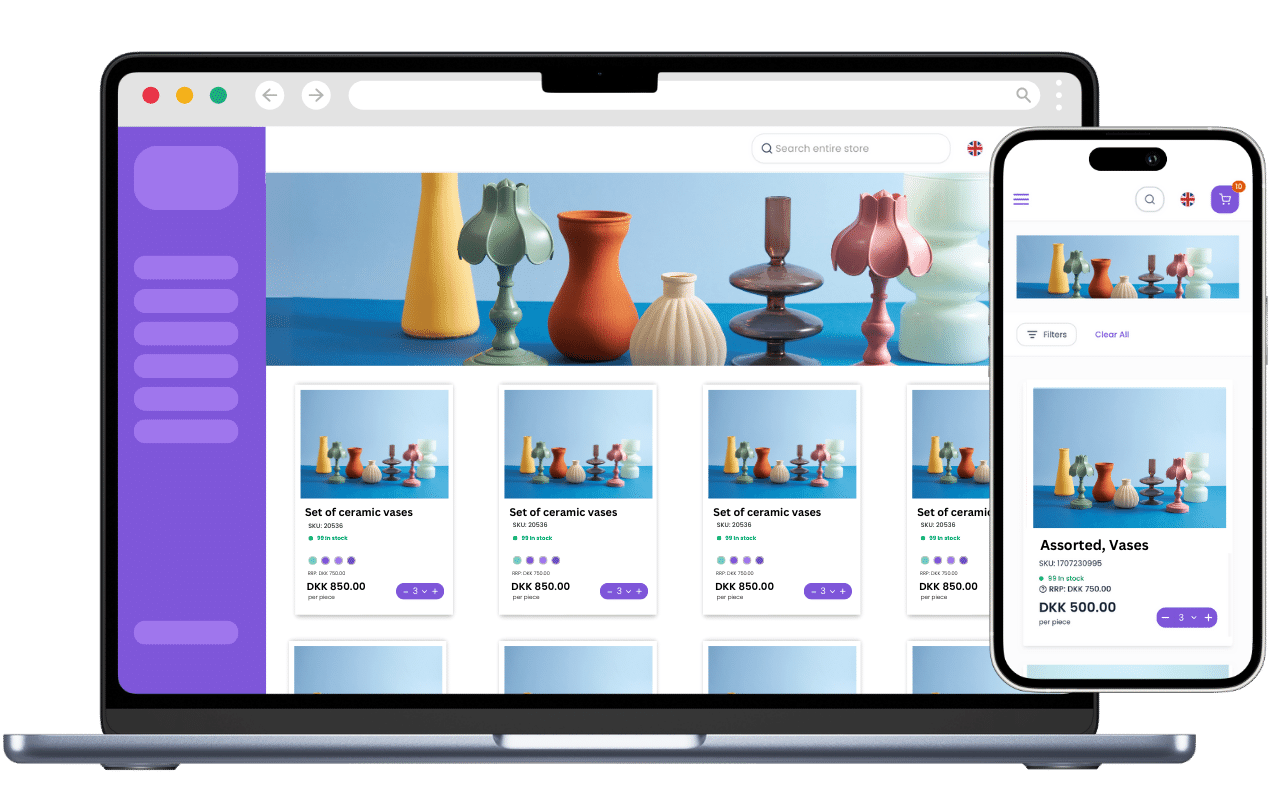
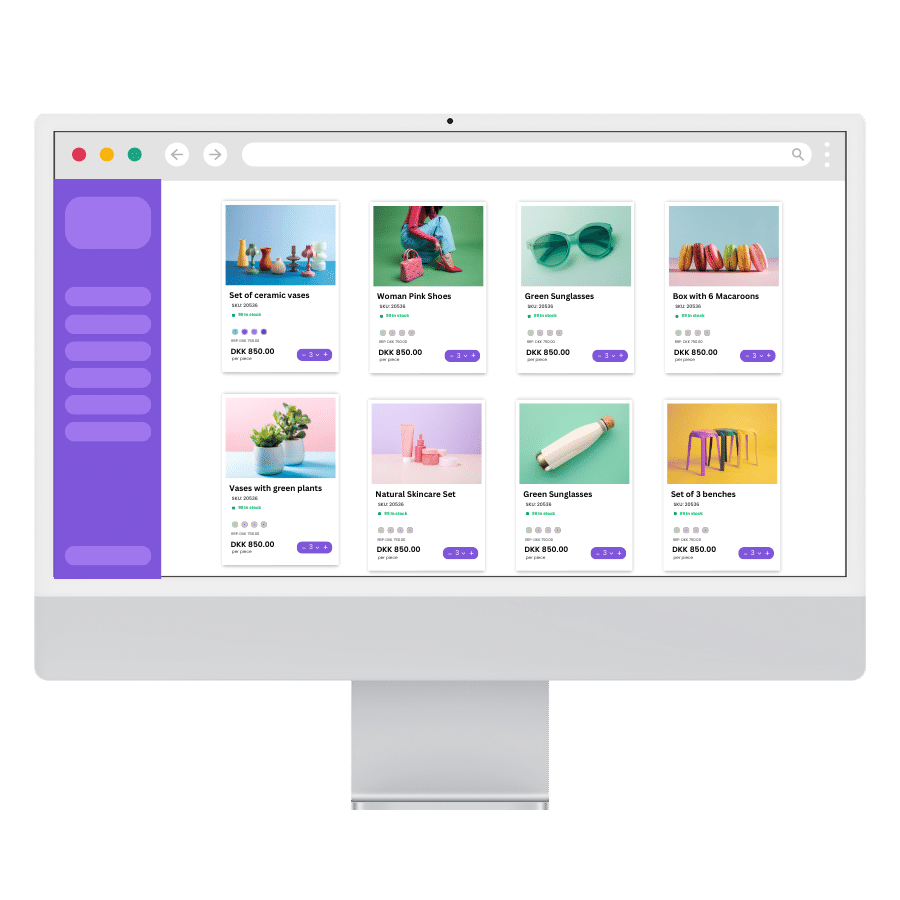
Made for B2B eCommerce and Wholesale Businesses
It sounds plain and simple but it’s not. B2B eCommerce requires something different than B2C. You need to put yourself in the mind of your B2B buyers. Buying your products is a task for them, not a personal motivation. That being said, B2B buyer expectations aligns with B2C in terms of the simplicity of how an order can be placed and the fact that they know their way around websites already.
It’s then on you, as a brand, to offer them the experience that allows them to place the so-much-more complicated B2B and wholesale orders online. Also known as B2B eCommerce.
Turis makes it easy for you in the way that we have taken care the B2B and wholesale eCommerce experience for you. At the same time we’ve included settings and customization that allows for your brand to be represented in your B2B eCommerce experience, with absolutely no need for any code or development to set things up or adjust them along the way.
Key Features and Benefits of Our B2B eCommerce Storefront
Order Management
From order placement to fulfillment, our streamlined order management process ensures efficiency and accuracy. Automated workflows reduce manual input, minimizing errors and speeding up order processing.
Product Management
Effortlessly manage your product listings, categories, and details with our intuitive product management system. Whether you’re updating prices, descriptions, or specifications, our platform simplifies these tasks, saving you time and reducing the risk of errors.
Customizable Interface
Your brand is unique, and your B2B storefront should be too. Our platform allows extensive customization of your B2B digital interface, ensuring it aligns perfectly with your brand identity. From color schemes and logos to layout and user experience.
Customer Segmentation
Our platform enables you to segment your customer base by various criteria, such as order history, preferences, and behavior. This allows for custom pricing, and tailored product offerings, improving the customer experience and loyalty.
Integration Capabilities
Seamless integration with your existing ERP, CRM, and other business systems is a cornerstone of our B2B storefront. This connectivity ensures that your eCommerce operations are fully aligned with your overall business processes.
Security and Compliance
In today’s digital world, security and compliance are paramount. Our platform is designed with the highest security standards in mind, protecting sensitive data and ensuring transactions are secure.
Summarizing eCommerce orders the B2B way
B2B eCommerce customers care about things like Minimum Order Amounts, number of cases and items on the order, SKU numbers and VAT information (and the ability to show this based on customer specifications).
They also need to be able to quickly make changes to several order lines as they will most likely have a high amount of lines on the order. Making changes needs to be possible in an efficient manner. No page loads or pop ups needed to make simple changes.

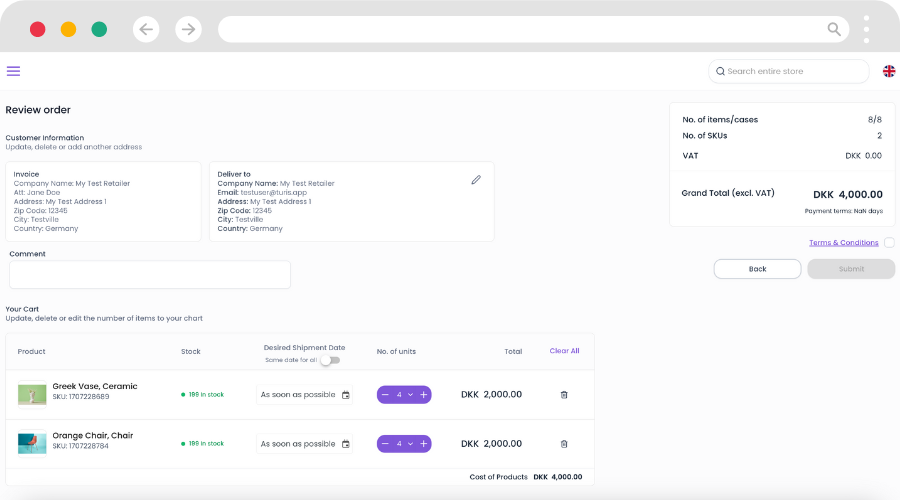
B2B eCommerce checkout is a breeze
Your B2B customers use your checkout way more often than any other customer type. It needs to be possible to breeze through this section.
To make that possible, the Turis checkout section has a structured and clear overview of the most important components to your B2B eCommerce checkout.
This relates to the invoice address, available delivery addresses (ability to add new ones), P.O. numbers, order lines and they payment/submission area (including applicable payment terms, payment options).
Everything is structured in a natural flow that guides your user through the order and all the way to checkout and order submission.
What is a B2B Storefront?
A B2B eCommerce storefront is a digital platform specifically designed for the complex needs and operations of business-to-business transactions. Unlike B2C, which focuses on selling to individual consumers, a B2B storefront caters to the unique requirements of wholesale buyers and organizations. It facilitates a more relationship-driven approach, where transactions are part of broader, ongoing partnerships. Those managing B2B operations often have specialized roles within their organizations, focusing on maintaining and enhancing these business relationships. In essence, a B2B storefront is not just about making sales; it’s about creating a seamless, efficient channel for sustained business interactions and growth.
The Core Differences of B2C and B2B eCommerce
| B2C | B2B | |
| Sales | Higher margin | Lower margin |
| Volume | Low | High |
| Complexity | Low | High |
| Customer Relationship | One customer group | Many customer groups |
| Business Processes | Simple | Complicated |
| Impact of errors (incorrect shipping, ordered items, …) | Small | High |
| Individualization | None | Need-to-have |
| Order frequency | Low | High |
| Customer approval | None | All |
| Items Ordered | A few | A lot |
| Payments | Upfront | Upfront, invoice, deposits |
| Currencies | One or more (customer selects) | Set for each customer (market dependent) |
| Single Customer Importance (account management) | Low | High |
| Integrations | Limited | Multiple |
| Business Efficiency Impact | Low | High |
| Typical Share of Total Sales | 20% | 80% |
The table above highlights some of the key differences in B2C and B2B eCommerce.
Although eCommerce is the general term regardless of what sales channel you deploy the technology to, the nature of them are very different.
However, we are able to compare the two in terms of features and user needs.
By doing that, it becomes apparent that the use cases for each sales channel call for completely different features or handling.
To put things into general terms, let’s work with an example
There’s a shoe brand.
They sell shoes all over the world – to retailers (B2B and wholesale) as well as consumers (B2C and D2C).
Sounds like a pretty straightforward business, right?
B2C Experience
My B2C customers typically find my brand via Google searches, via online campaigns and social media. They browse my B2C eCommerce site, they select where they are ordering from and we show them the products we have. We use a lot of images to showcase the individual product, for some products we even have videos of a person wearing the shoes.
When the B2C customer browses our site, they are exposed to discounts, vouchers by signing up to newsletters, seasonal offers and things like that.
We spend a lot of time describing our return process as this is very important to B2C customers as we sell shoes, which is considered a product that is difficult to purchase online as it is impossible to know if they’ll fit.
Since the B2C customer is based in a region with a different sizing scheme than the one we default to, we have a size guide pop up that displays the shoe sizes in a comparison table. We have sizes for US, UK, EU, and China. For each region we have three categories for sizes, Mens, Womens and Kids.
Some customers buy two of the same pair of shoes in different sizes. When they do so, we know that one pair is going to be returned. Potentially even both of them.
When the B2C customer has decided to purchase a pair of shoes, they go to checkout, but first they are blocked by an upsell campaign where we try to sell them some shoe care products. After skipping the campaign or selecting a product, the customer is taken to the checkout section.
In the checkout section they input all of their information in order to be able to pay for the products and finally receive them.
During the checkout process, the customer’s shipping is re-calculated (if they are not within the default shipping zone).
Once they’ve filled out the checkout form, they select their payment method and the order goes through final processing.
Based on the customer’s location, they might be prompted by their bank or government official security service to approve the transaction.
All that the B2C customer has to do at this point is to go back to the checkout section, enter the 6-digit security code to approve the transaction, and click complete.
That is what it takes for a B2C customer to place an online order for a single pair of shoes.
The checkout process for a B2C customer relies heavily on the individual products and exposure of various marketing elements to (hopefully) squeeze that extra product into the order before it is submitted.
You’ll also notice that a lot of the elements in the B2C checkout flow focuses on the individual as they are the end-user of the product. They relate to the product as not just the potential buyer of it, but also the user of it.
The transaction for a B2C customer is simple in a lot of terms. The order has one or a few products, all users are considered the same, the customer has to deal with what’s in front of them to complete their purchase and there’s no or very limited purchase consideration.
The business value of the transaction is equally simple/small. There’s no way the B2C customer can be handled in any other way than the rest of the group. That’s the very essence of a B2C eCommerce effort. To be able to serve this customer group efficiently, we need to offer them an experience that facilitates that.
B2B Experience
Our B2B customers are special. We have a brand strategy that also relates to the retailers and B2B accounts that we work with. This also goes for the potential B2B customers we have. We can’t just accept anyone without evaluating if it’s a business that aligns with the profile that we want to work with (this could be in terms of the type of business it is, where it is located, the customer segment that they serve, existing B2B customers in the same area, and so on). To protect our brand and how it is perceived, we just need to review any potential partnership.
We use a Retailer Request Form in Turis to do that. We’ve added fields for what we want to ask our customers. When they submit the form, we get a notification and if everything checks out, we approve it.
The B2B customer has now received a notification with a magic link to our B2B eCommerce site.
They click the link and they’re in.
The customer can browse all the products we’ve given them access to with a price list that matches the customer type.
Unlike the B2C example, my B2B customer is not shopping for themselves. They are buying products for one or more retail locations. Still, it is important that our brand identity is reflected in our B2B eCommerce storefront. With Turis we can do that just how we’d like to with no code or developers, all while preserving the most efficient checkout flow for B2B and wholesale orders. We can create custom pages using drag and drop, we can add banners to category pages, customize our login page with our logo and an image showing our current collection.
When a B2B customer is purchasing shoes from us, the sizing challenge the B2C customer had is not present. For the B2B customer, sizing is all about purchasing the individual shoes in a size range relevant to their store (it might be kids, adults or a mix). To make it easy for the customer to do that, we have set up our products in a line view in Turis that shows the core shoe itself along with all the sizes (in the size applicable to the retailer’s region) and the B2B customer can select all the sizes they want, and for each color way, right there in one pop up.
The line view is relevant for any type of product that comes in several colors and sizes and makes it super easy for B2B customers to buy the exact selection they need (and ultimately entices them to go for a bigger range that they normally would).
Here’s a simplified example featuring a basic t-shirt

With just a few clicks, the customer has added a bunch of shoes to the order. Different styles, multiple sizes and colorways. Exactly how we’d like our B2B customers to order, handled and guided in the simplest manner by Turis.
The Turis B2B storefront has been purposely built for B2B and wholesale which means that the ordering process is all about that. This means that your B2B buyers can quickly get an overview of the products you offer, the categories, the variant options and finally they are able to add the products they want with a minimum of effort.
This is also why that brands on Turis get comments on orders from buyers praising the super simple ordering process that actually gives them an easier way to place more complicated orders.
When the customer is ready to submit their order, they get this nice and informative preview of their order
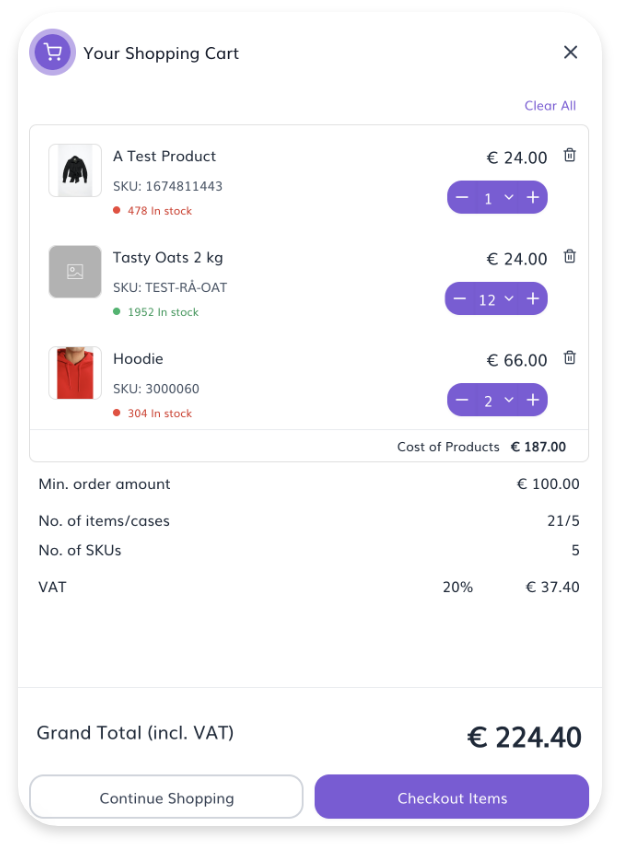
It has exactly the information a B2B buyer needs and based on the way that such a customer makes purchases. SKUs are important (your customer can often recognize a product on the SKU), their minimum order amount (in general or for them individually), the number of cases they are ordering and how many unique types of products that represent this as well as the VAT information (if VAT applies to the customer).
From this point, the customer can easily edit their order or go directly to checkout.
Remember the B2C checkout process? Well, B2B eCommerce is also very different on this area. We already know the customer, their delivery addresses, their payment terms (and thereby the payment options, invoice, credit card or freedom to choose what they prefer).
Some B2B customers order way in advance to prepare for seasonality (for instance) and find it very important to be able to select a desired order date for individual products). By keeping history of your customer’s purchase history in a CRM (such as HubSpot), you can even plan structured outreach with different forms of communications (tapping into newsletter platforms like Mailchimp).
If you sell a special type of products that require documentation to go with the order, your customer can even upload a file that you can access in the order data.
Does your customer have a Purchase Order number from their internal systems? No problem – they can add it in the PO field and it will also be featured on the order data (this can go from the order to your ERP or accounting system using one of many integrations, such as Xero).
It’s confetti time
Turis ships with confetti pre-installed. If that’s a bit too cheery for you and your brand, don’t worry – it can be turned off in your settings.
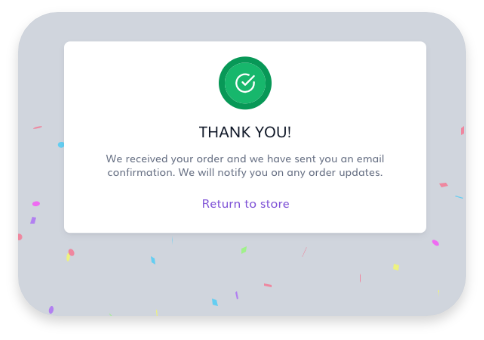
Now we’ve placed a B2B order of 129 products.
We’ve made sure that the customer was able to easily add the relevant variations and sizes and in general provided an eCommerce experience made for B2B and wholesale allowing the customer to focus on stocking up, rather than trying to figure out how to order in the first place.
There’s more
What about all the information and documentation that is often required in B2B transactions?
When a customer has placed their order, they can download the order as a .csv, they can download order documents as PDFs just like we’ve already sent them an email with all the high resolution product images for the exact products they’ve purchased (your way of making sure that the customer doesn’t just search for your products online and download a low resolution image and put it on their web shop).
Other relevant B2B features
B2B & Wholesale Management
- Product Import Import all of your products effortless with our bulk importer or connect a data source
- Product Content Enable your retailers to download your content in your automatically updated Image & Content Bank
- Retailer Management Create Retailers and their associated contacts to provide the right people with personal access to browse and buy wholesale from you
- Order Management Manage wholesale orders and automatically notify customers on order changes/updates
- Bulk Data Import Import data in bulk for multiple properties
- Tax Settings Support for differentiated tax on product, country and customer level (including support for tax exempt customers)
- Integrations Connect Turis with more than 4,000 other platforms – no coding required
- API Take integrations a step further with our Open API and develop exactly what you need
- Language & Translations Turis is available in more than 180 languages
- Price Lists & Discounts Turis supports wholesale prices and discounts on multiple levels to satisfy almost any need for individualization
- Sales Agents Add sales agents and assign them to retailers to allow them to place orders on behalf of the customers they represent
- Stock Management Manage your stock directly in Turis, with a ready made integration, an app or develop your own integration with our API
- Payments You don’t need to rely only on invoice payments. Accept credit card payments from all or selected customers
B2B eCommerce Storefront
- Customizable eCommerce storefront made for wholesale Implement your brand and visual identity in the wholesale customer experience
- Simply and wholesale-efficient product overview Display your products visually, categorized and neatly organized to allow for fast ordering (and re-ordering)
- Product Variants Structure your products with different variant settings depending on your product types and how your customers purchase them
- Password Protected Customers need access to purchase via Turis. When you create customers and contacts we automatically send them an invite – no additional setup required
- Share Product Catalog Need to share an open product catalog to potential customers? No problem – Turis comes with a link where users can browse product information (no wholesale prices, though)
- Image and Content Bank Your customers have easy access to product content. You don’t even need to maintain it – just create your products and your users can download what they need directly in Turis
- Express Ordering Allow customers (all or specific ones) to place large orders with only a few clicks
- Retailer Specific Languages Make ordering easier by setting the language for specific retailers
- Personal Buyer Logins No need to use shared logins – all buyers can get their own individual logins
- Branded Login Page Put your wholesale customers in your brand universe by serving them a login page them can recognize and be inspired by
- Custom URL We’ll provide you with a free subdomain by default. If you want a custom URL (e.g. wholesale.yourwebsite.com we can offer you that as well)
- Buyer Order History No need for buyers to browse email inboxes for order confirmations. Buyer can login and browse their order history and recent order updates
- Notifications Send order confirmations, order changes or other updates automatically as changes occur
B2B Platform Support
- In-Platform Chat Support We are all about great support. Reach us on the in-platform chat for instant response to most queries
- E-Mail Support Prefer email? Don’t worry! We offer email support as well if your question needs a bigger canvas